Dr. Drakelove or: How I Learned to Stop Worrying and Jund 'em Out
- PDH Home Base

- Feb 21, 2018
- 8 min read

Let’s begin today with a brief anecdote. I’ve been doing a lot of brewing over the last few weeks, one list in particular being a mill deck. There are plenty of good synergies and even a well designed commander for the archetype, so it seemed like an interesting place to explore. Right after I culled the list down to 100 cards, it hit me like a sack of potatoes -- If the ultimate goal is to mill out the entire table, there is no reason not to just do it with Peregrine Drake/Ghostly Flicker loops with Sage’s Row Denizen. There is no need to build around things like Duskmantle Guildmage or Jace’s Erasure when we can just build a blue/black control deck aiming to go infinite with Peregrine Drake as the route to victory. To not do so is just way too inefficient by comparison. Peregrine Drake trivialized the strategy, and I knew it was time to move on.
Except for the fact that I really couldn’t move on. Whenever I would put pen to paper and list out a blue deck, I would always find myself squaring off against the presence of Peregrine Drake. The cost in deck construction is so little (the common suite of cards used to combo with Peregrine Drake is comprised of tools that are already mostly auto-includes for blue decks) that there simply is no compelling reason to exclude a combo line through Peregrine Drake. Archetype and primary game-plan are largely irrelevant. Needless to say, I jumped ship pretty fast as far as blue decks were concerned. I wanted nothing to do with Peregrine Drake and its ilk, and left in search of a broader and more open brewing environment, and that’s exactly what I ended up finding.
I found Jund.
The motto and guiding principle of Jund is a simple one: “We are not a blue deck.” We don’t have access to things like Ponder, Preordain, or Brainstorm. We don’t have access to Rhystic Study, Ghostly Flicker, or Rush of Knowledge. There are a lot of very powerful card advantage tools and draw spells that we just don’t have the ability to work with, and trying to imitate their function is an ultimately fruitless endeavor -- there is a marked difference between being a Not-Blue deck and a Bad Blue deck. That being said, we have to be able to find a way to keep up with cards like those if we want to be able to hold our own at a multiplayer table.The draw spells that we do have access to just won’t be able to compete pound for pound, and it’s unrealistic to devote a certain amount of slots in our deck to shore up that particular avenue. We could run as many functional copies of Night’s Whisper in the deck as we want, but it will never reach quite the same level as if we simply had the ability to just cast and recur Secrets of the Golden City. We have to find another way to keep the gas tank full. A way that can play to our strengths instead of always being on the back foot.

The first step to understanding how a deck like Jund can function in pauper EDH lies in coming to terms with the implications of Tortured Existence. Black/green midrange decks seem to be the opposite of what I found in the blue midrange decks; the primary difference comes in where we are able to set up our value engines. In blue based decks, this is done mostly through the capacity to sculpt our hand. These decks are able to leverage cards like Ponder, Preordain, Brainstorm, Rhystic Study, etc. to either assemble the components they need, or skip over the components they don’t. Conversely, black/green decks can accomplish the same goal through the graveyard, and the biggest payouts come from the ability to leverage that graveyard into something of an honorary hand of cards, which then allows for some level of parity in terms of card advantage.
Tortured Existence is a prime example of this. Recursion is an important aspect of pauper EDH for any deck, regardless of color, and it’s an important tool in keeping black/green decks relevant in the mid-late game. At first blush, Tortured Existence doesn’t really seem to provide any card advantage at all. Essentially, we are just using it to exchange resources on a one for one basis. However, that starts to change when we begin to take advantage of creatures that are able to create card advantage, virtual or otherwise, and then introduce them into a Tortured Existence engine. In my last article, I wrote at some length about Dusk Legion Zealot.

Without getting too much into it, the thrust was that cards like this replace themselves in our hand while adding a resource to our battlefield, thus pulling more or less even in many ways with more traditional draw spells. When put into the context of Tortured Existence, we can easily set up an engine alongside cards like Shambling Shell, Stinkweed Imp, Sanitarium Skeleton, or other creatures that can easily be returned to hand and discarded once again to Tortured Existence. We are then able to loop creatures like Dusk Legion Zealot for cards, Farhaven Elf for lands, etc. The list goes on. It’s a potent engine and while it does have some deck building demands, those demands don’t take us too far outside of things that we would want to be doing anyway. This is a color combination that is already drawn to value creatures so it only makes sense to build in an engine to perpetuate their impact.
On the other hand, that same engine can be utilized to shift gears from a value-centric game plan into one of inevitability to close out the game. Grinding through the game on the back of Dusk Legion Zealot and friends is one thing, but using that same engine to stick an Ulamog’s Crusher through any number of removal spells is something different entirely. It is this ability to adapt its game plan that is central to a successful mid-range deck, and it is what makes a Tortured Existence engine one of the most defining mid-range strategies of the format.
I think that Jund mid-range is unique among Tortured Existence decks in that it can be conceptualized both on a black/red and black/green base. There is a significant amount of powerful card advantage that seems to be built into the area where the black and red cards intersect, and this is demonstrated most clearly in the madness mechanic, so let’s explore that a little bit.
This is an example of where Tortured Existence can start to fit into a larger context. By being able to utilize madness creatures with Tortured Existence et al, or taking advantage of madness spells through other various discard outlets, we can operate at a much more efficient rate than other midrange decks. We can also turn out a positive level of card advantage where we weren’t able to before. This is a space where Jund can really shine and show off its ability to grind through other decks. The ability to capitalize on madness cards gives it the ability to stay flush with resources while simultaneously playing to the board. Take, for example, Tormenting Voice.

Tormenting Voice is a good enough card in any red deck. It doesn’t put us up on cards, but it does let us at least see a couple new ones and filter our hand a little bit. It is totally fine on its own. However, coupled with a madness spell, we actually are able to generate an extra card and pull ahead on resources. We are able to leverage that discarded card, otherwise lost, into an above-rate creature or spell, giving us access to explosive sequences and turns. This is true for any card, creature or otherwise, that requires us to discard a card either as part of its casting cost, enters-the-battlefield trigger, or ability activation. Something like Miasmic Mummy or Sibsig Icebreakers can turn into a huge tempo swing if they come down with an Arrogant Wurm to follow; suddenly, we can take efficiently costed symmetrical discard effects and attack our opponents’ hands while coming out ahead of the table in a tangible way.
Madness is a great starting point for a deck like this simply because of the way that it naturally leads to some other synergies that carry powerful effects without adding any real deck building costs. Once we realize that discarding our own cards for fun and profit is a viable way to generate resources and card advantage, we don’t have to do much work to make Horror of the Broken Lands and Grisly Survivor, for example, powerful standalone threats. These are cards that slot very naturally into the plan we’ve already crafted.
The beauty of Jund is that this madness-centric build I’ve been discussing thus far is only one of many ways we can purpose these cards. Jund is completely saturated, with tangential synergies, but it also raises a big issue that a good pilot needs to be aware of. The main issue with a deck like this comes in the need to have a certain level of enablers and the payouts to use alongside them. We need to keep this in mind when building a final list, and it is an important guiding principle when decided just how many of those aforementioned tangential synergies we want to put on display. This limitation is what gives Jund it's breadth of different viable builds -- we simply just can't fit everything into one cohesive deck list. We can jam all of our madness/dredge/cycling/unearth/scavenge/delve cards together until the cows come home, but they all play off of different tensions, regardless of their overlapping synergies. Jund is great from a brewing perspective because of that necessity to mix and match and see what works best.
This flexible identity is characterized by the available commanders. They each pull in different directions but can find a role in any number of approaches. Scarland Thrinax and Sprouting Thrinax, for example, can both serve as the commander for a more aristocrats (or, sacrifice for value) oriented approach, while each coming to the strategy from a different perspective -- one being a sacrifice outlet, and the other being a payout. Thunderscape Battlemage and Jund Battlemage can serve a more well-rounded “good stuff” or control plan. However, Thunderscape Battlemage can also head up a more discard or even madness-based approach as an enabler (don't forget we can target ourselves with the black kicker in a pinch!), and Jund Battlemage can fit into an aristocrats shell as well through its ability to generate tokens to sacrifice. They all do very different things but work towards similar goals based almost entirely on how we want to build our deck.
I could talk about how to approach Jund until the day I die and still probably not cover it all. Hopefully the approaches we discussed here give you a good idea of the different paths you could take to go about building a Jund deck of your own. Breathe a sigh of relief knowing that finally you don’t have to start with a Peregrine Drake package and work backwards in order to have a powerful deck executing a powerful strategy. But enough about that -- what synergies are you interested in exploring in a prospective Jund deck? Do you see any untapped potential in the available commanders? Let me know over on the PDH Homebase Discord channel!
-Derek
@PDH_Homebase


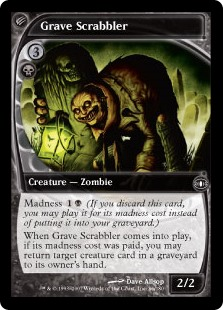

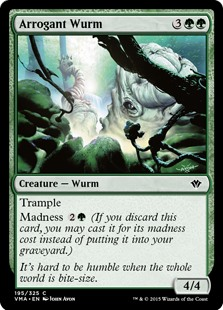

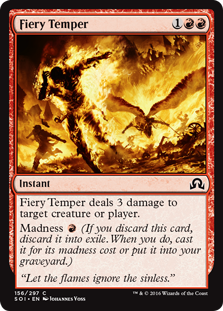

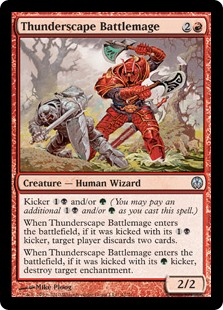

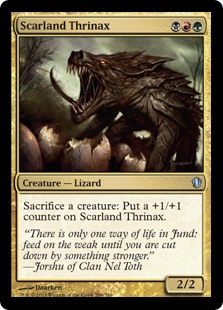

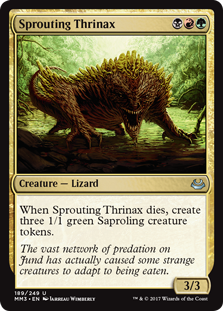

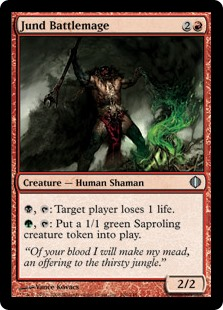



Comments